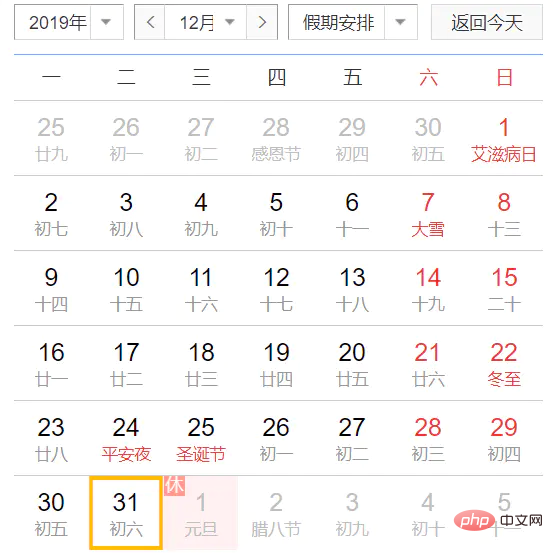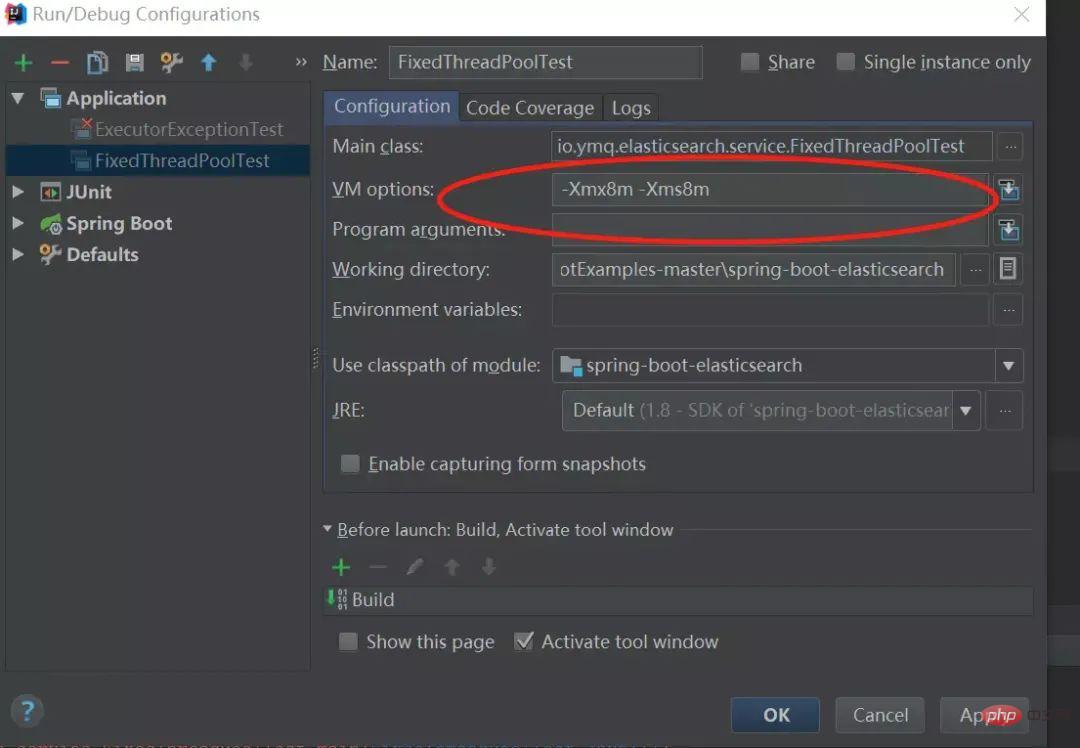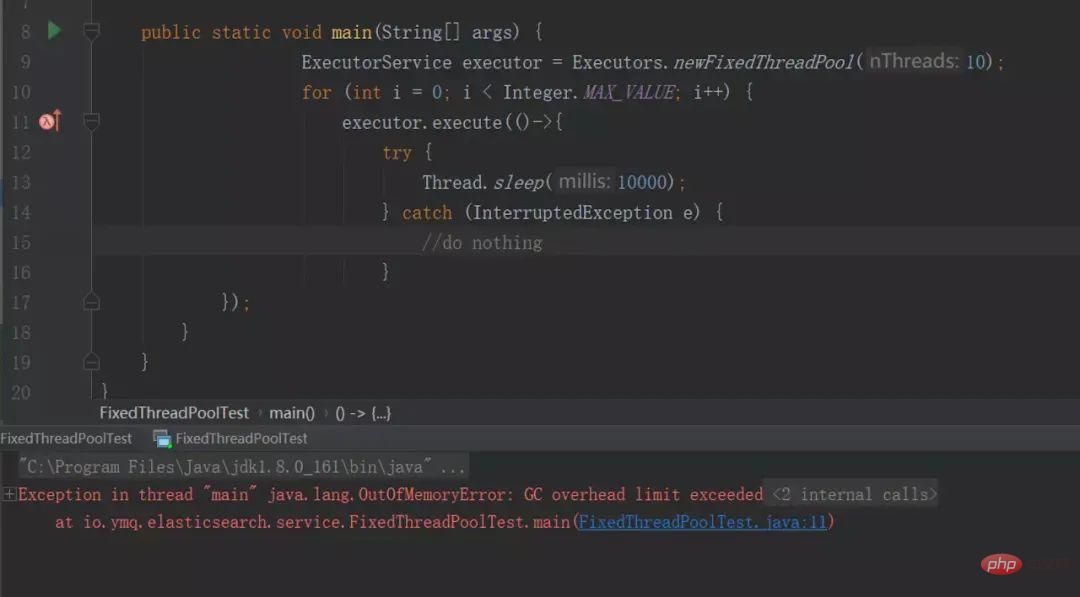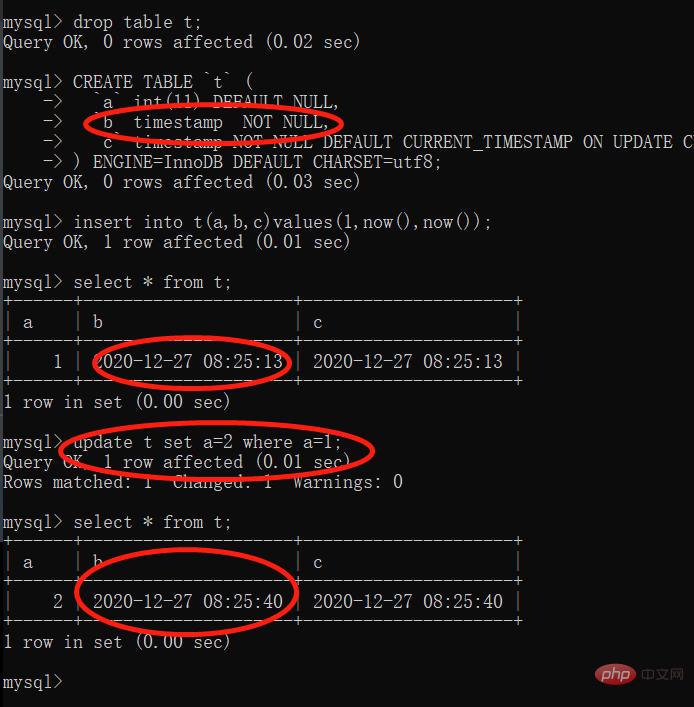Home >Java >javaTutorial >21 pitfalls in daily Java development, how many have you stepped on?
21 pitfalls in daily Java development, how many have you stepped on?
- Java后端技术全栈forward
- 2023-08-24 15:47:22769browse
Preface
I recently read "Java Business" by Geek Time "100 Examples of Common Development Mistakes", combined with some code pits that I usually encounter, I will write a summary. I hope it will be helpful to everyone. Thank you for reading~
1. Six types of typical null pointer problems
Packaging type Null pointer problem Null pointer problem for cascading calls Null pointer problem on the left side of the Equals method -
Containers such as ConcurrentHashMap do not support Key and Value being null. Collections, arrays directly obtain elements Objects directly obtain attributes
1.1 Null pointer problem of packaging type
public class NullPointTest {
public static void main(String[] args) throws InterruptedException {
System.out.println(testInteger(null));
}
private static Integer testInteger(Integer i) {
return i + 1; //包装类型,传参可能为null,直接计算,则会导致空指针问题
}
}
##1.2 Null pointer problem with cascading callspublic class NullPointTest {
public static void main(String[] args) {
//fruitService.getAppleService() 可能为空,会导致空指针问题
fruitService.getAppleService().getWeight().equals("OK");
}
}
##1.3 Null pointer problem on the left side of Equals method
1.4 Containers such as ConcurrentHashMap do not support Key, and Value is null.
public class NullPointTest {
public static void main(String[] args) {
Map map = new ConcurrentHashMap<>();
String key = null;
String value = null;
map.put(key, value);
}
}1.5 集合,数组直接获取元素
public class NullPointTest {
public static void main(String[] args) {
int [] array=null;
List list = null;
System.out.println(array[0]); //空指针异常
System.out.println(list.get(0)); //空指针一场
}
}1.6 对象直接获取属性
public class NullPointTest {
public static void main(String[] args) {
User user=null;
System.out.println(user.getAge()); //空指针异常
}
}2. 日期YYYY格式设置的坑
日常开发,经常需要对日期格式化,但是呢,年份设置为YYYY大写的时候,是有坑的哦。
反例:
Calendar calendar = Calendar.getInstance();
calendar.set(2019, Calendar.DECEMBER, 31);
Date testDate = calendar.getTime();
SimpleDateFormat dtf = new SimpleDateFormat("YYYY-MM-dd");
System.out.println("2019-12-31 转 YYYY-MM-dd 格式后 " + dtf.format(testDate));运行结果:
2019-12-31 转 YYYY-MM-dd 格式后 2020-12-31
「解析:」
为什么明明是2019年12月31号,就转了一下格式,就变成了2020年12月31号了?因为YYYY是基于周来计算年的,它指向当天所在周属于的年份,一周从周日开始算起,周六结束,只要本周跨年,那么这一周就算下一年的了。正确姿势是使用yyyy格式。

正例:
Calendar calendar = Calendar.getInstance();
calendar.set(2019, Calendar.DECEMBER, 31);
Date testDate = calendar.getTime();
SimpleDateFormat dtf = new SimpleDateFormat("YYYY-MM-dd");
System.out.println("2019-12-31 转 YYYY-MM-dd 格式后 " + dtf.format(testDate));3.金额数值计算精度的坑
看下这个浮点数计算的例子吧:
public class DoubleTest {
public static void main(String[] args) {
System.out.println(0.1+0.2);
System.out.println(1.0-0.8);
System.out.println(4.015*100);
System.out.println(123.3/100);
double amount1 = 3.15;
double amount2 = 2.10;
if (amount1 - amount2 == 1.05){
System.out.println("OK");
}
}
}运行结果:
0.30000000000000004 0.19999999999999996 401.49999999999994 1.2329999999999999
可以发现,结算结果跟我们预期不一致,其实是因为计算机是以二进制存储数值的,对于浮点数也是。对于计算机而言,0.1无法精确表达,这就是为什么浮点数会导致精确度缺失的。因此,「金额计算,一般都是用BigDecimal 类型」
对于以上例子,我们改为BigDecimal,再看看运行效果:
System.out.println(new BigDecimal(0.1).add(new BigDecimal(0.2))); System.out.println(new BigDecimal(1.0).subtract(new BigDecimal(0.8))); System.out.println(new BigDecimal(4.015).multiply(new BigDecimal(100))); System.out.println(new BigDecimal(123.3).divide(new BigDecimal(100)));
运行结果:
0.3000000000000000166533453693773481063544750213623046875 0.1999999999999999555910790149937383830547332763671875 401.49999999999996802557689079549163579940795898437500 1.232999999999999971578290569595992565155029296875
发现结果还是不对,「其实」,使用 BigDecimal 表示和计算浮点数,必须使用「字符串的构造方法」来初始化 BigDecimal,正例如下:
public class DoubleTest {
public static void main(String[] args) {
System.out.println(new BigDecimal("0.1").add(new BigDecimal("0.2")));
System.out.println(new BigDecimal("1.0").subtract(new BigDecimal("0.8")));
System.out.println(new BigDecimal("4.015").multiply(new BigDecimal("100")));
System.out.println(new BigDecimal("123.3").divide(new BigDecimal("100")));
}
}在进行金额计算,使用BigDecimal的时候,我们还需要「注意BigDecimal的几位小数点,还有它的八种舍入模式哈」。
4. FileReader默认编码导致乱码问题
看下这个例子:
public class FileReaderTest {
public static void main(String[] args) throws IOException {
Files.deleteIfExists(Paths.get("jay.txt"));
Files.write(Paths.get("jay.txt"), "你好,捡田螺的小男孩".getBytes(Charset.forName("GBK")));
System.out.println("系统默认编码:"+Charset.defaultCharset());
char[] chars = new char[10];
String content = "";
try (FileReader fileReader = new FileReader("jay.txt")) {
int count;
while ((count = fileReader.read(chars)) != -1) {
content += new String(chars, 0, count);
}
}
System.out.println(content);
}
}运行结果:
系统默认编码:UTF-8 ���,�����ݵ�С�к�
从运行结果,可以知道,系统默认编码是utf8,demo中读取出来,出现乱码了。为什么呢?
❝FileReader 是以当「前机器的默认字符集」来读取文件的,如果希望指定字符集的话,需要直接使用 InputStreamReader 和 FileInputStream。
❞
正例如下:
public class FileReaderTest {
public static void main(String[] args) throws IOException {
Files.deleteIfExists(Paths.get("jay.txt"));
Files.write(Paths.get("jay.txt"), "你好,捡田螺的小男孩".getBytes(Charset.forName("GBK")));
System.out.println("系统默认编码:"+Charset.defaultCharset());
char[] chars = new char[10];
String content = "";
try (FileInputStream fileInputStream = new FileInputStream("jay.txt");
InputStreamReader inputStreamReader = new InputStreamReader(fileInputStream, Charset.forName("GBK"))) {
int count;
while ((count = inputStreamReader.read(chars)) != -1) {
content += new String(chars, 0, count);
}
}
System.out.println(content);
}
}5. Integer缓存的坑
public class IntegerTest {
public static void main(String[] args) {
Integer a = 127;
Integer b = 127;
System.out.println("a==b:"+ (a == b));
Integer c = 128;
Integer d = 128;
System.out.println("c==d:"+ (c == d));
}
}运行结果:
a==b:true c==d:false
为什么Integer值如果是128就不相等了呢?「编译器会把 Integer a = 127 转换为 Integer.valueOf(127)。」 我们看下源码。
public static Integer valueOf(int i) {
if (i >= IntegerCache.low && i <= IntegerCache.high)
return IntegerCache.cache[i + (-IntegerCache.low)];
return new Integer(i);
}可以发现,i在一定范围内,是会返回缓存的。
❝默认情况下呢,这个缓存区间就是[-128, 127],所以我们业务日常开发中,如果涉及Integer值的比较,需要注意这个坑哈。还有呢,设置 JVM 参数加上 -XX:AutoBoxCacheMax=1000,是可以调整这个区间参数的,大家可以自己试一下哈
❞
6. static静态变量依赖spring实例化变量,可能导致初始化出错
之前看到过类似的代码。静态变量依赖于spring容器的bean。
private static SmsService smsService = SpringContextUtils.getBean(SmsService.class);
这个静态的smsService有可能获取不到的,因为类加载顺序不是确定的,正确的写法可以这样,如下:
private static SmsService smsService =null;
//使用到的时候采取获取
public static SmsService getSmsService(){
if(smsService==null){
smsService = SpringContextUtils.getBean(SmsService.class);
}
return smsService;
}7. 使用ThreadLocal,线程重用导致信息错乱的坑
使用ThreadLocal缓存信息,有可能出现信息错乱的情况。看下下面这个例子吧。
private static final ThreadLocal<Integer> currentUser = ThreadLocal.withInitial(() -> null);
@GetMapping("wrong")
public Map wrong(@RequestParam("userId") Integer userId) {
//设置用户信息之前先查询一次ThreadLocal中的用户信息
String before = Thread.currentThread().getName() + ":" + currentUser.get();
//设置用户信息到ThreadLocal
currentUser.set(userId);
//设置用户信息之后再查询一次ThreadLocal中的用户信息
String after = Thread.currentThread().getName() + ":" + currentUser.get();
//汇总输出两次查询结果
Map result = new HashMap();
result.put("before", before);
result.put("after", after);
return result;
}按理说,每次获取的before应该都是null,但是呢,程序运行在 Tomcat 中,执行程序的线程是 Tomcat 的工作线程,而 Tomcat 的工作线程是基于线程池的。
❝线程池会重用固定的几个线程,一旦线程重用,那么很可能首次从 ThreadLocal 获取的值是之前其他用户的请求遗留的值。这时,ThreadLocal 中的用户信息就是其他用户的信息。
❞
把tomcat的工作线程设置为1
server.tomcat.max-threads=1
用户1,请求过来,会有以下结果,符合预期:

用户2请求过来,会有以下结果,「不符合预期」:

因此,使用类似 ThreadLocal 工具来存放一些数据时,需要特别注意在代码运行完后,显式地去清空设置的数据,正例如下:
@GetMapping("right")
public Map right(@RequestParam("userId") Integer userId) {
String before = Thread.currentThread().getName() + ":" + currentUser.get();
currentUser.set(userId);
try {
String after = Thread.currentThread().getName() + ":" + currentUser.get();
Map result = new HashMap();
result.put("before", before);
result.put("after", after);
return result;
} finally {
//在finally代码块中删除ThreadLocal中的数据,确保数据不串
currentUser.remove();
}
}8. 疏忽switch的return和break
这一点严格来说,应该不算坑,但是呢,大家写代码的时候,有些朋友容易疏忽了。直接看例子吧
/*
* 关注公众号:
* 捡田螺的小男孩
*/
public class SwitchTest {
public static void main(String[] args) throws InterruptedException {
System.out.println("testSwitch结果是:"+testSwitch("1"));
}
private static String testSwitch(String key) {
switch (key) {
case "1":
System.out.println("1");
case "2":
System.out.println(2);
return "2";
case "3":
System.out.println("3");
default:
System.out.println("返回默认值");
return "4";
}
}
}输出结果:
测试switch 1 2 testSwitch结果是:2
switch 是会「沿着case一直往下匹配的,知道遇到return或者break。」 所以,在写代码的时候留意一下,是不是你要的结果。
9. Arrays.asList的几个坑
9.1 基本类型不能作为 Arrays.asList方法的参数,否则会被当做一个参数。
public class ArrayAsListTest {
public static void main(String[] args) {
int[] array = {1, 2, 3};
List list = Arrays.asList(array);
System.out.println(list.size());
}
}运行结果:
1
Arrays.asList源码如下:
public static <T> List<T> asList(T... a) {
return new ArrayList<>(a);
}9.2 Arrays.asList 返回的 List 不支持增删操作。
public class ArrayAsListTest {
public static void main(String[] args) {
String[] array = {"1", "2", "3"};
List list = Arrays.asList(array);
list.add("5");
System.out.println(list.size());
}
}运行结果:
Exception in thread "main" java.lang.UnsupportedOperationException at java.util.AbstractList.add(AbstractList.java:148) at java.util.AbstractList.add(AbstractList.java:108) at object.ArrayAsListTest.main(ArrayAsListTest.java:11)
Arrays.asList 返回的 List 并不是我们期望的 java.util.ArrayList,而是 Arrays 的内部类 ArrayList。内部类的ArrayList没有实现add方法,而是父类的add方法的实现,是会抛出异常的呢。
9.3 使用Arrays.asLis的时候,对原始数组的修改会影响到我们获得的那个List
public class ArrayAsListTest {
public static void main(String[] args) {
String[] arr = {"1", "2", "3"};
List list = Arrays.asList(arr);
arr[1] = "4";
System.out.println("原始数组"+Arrays.toString(arr));
System.out.println("list数组" + list);
}
}运行结果:
原始数组[1, 4, 3] list数组[1, 4, 3]
从运行结果可以看到,原数组改变,Arrays.asList转化来的list也跟着改变啦,大家使用的时候要注意一下哦,可以用new ArrayList(Arrays.asList(arr))包一下的。
10. ArrayList.toArray() 强转的坑
public class ArrayListTest {
public static void main(String[] args) {
List<String> list = new ArrayList<String>(1);
list.add("公众号:捡田螺的小男孩");
String[] array21 = (String[])list.toArray();//类型转换异常
}
}因为返回的是Object类型,Object类型数组强转String数组,会发生ClassCastException。解决方案是,使用toArray()重载方法toArray(T[] a)
String[] array1 = list.toArray(new String[0]);//可以正常运行
11. 异常使用的几个坑
11.1 不要弄丢了你的堆栈异常信息
public void wrong1(){
try {
readFile();
} catch (IOException e) {
//没有把异常e取出来,原始异常信息丢失
throw new RuntimeException("系统忙请稍后再试");
}
}
public void wrong2(){
try {
readFile();
} catch (IOException e) {
//只保留了异常消息,栈没有记录啦
log.error("文件读取错误, {}", e.getMessage());
throw new RuntimeException("系统忙请稍后再试");
}
}正确的打印方式,应该酱紫
public void right(){
try {
readFile();
} catch (IOException e) {
//把整个IO异常都记录下来,而不是只打印消息
log.error("文件读取错误", e);
throw new RuntimeException("系统忙请稍后再试");
}
}11.2 不要把异常定义为静态变量
public void testStaticExeceptionOne{
try {
exceptionOne();
} catch (Exception ex) {
log.error("exception one error", ex);
}
try {
exceptionTwo();
} catch (Exception ex) {
log.error("exception two error", ex);
}
}
private void exceptionOne() {
//这里有问题
throw Exceptions.ONEORTWO;
}
private void exceptionTwo() {
//这里有问题
throw Exceptions.ONEORTWO;
}exceptionTwo抛出的异常,很可能是 exceptionOne的异常哦。正确使用方法,应该是new 一个出来。
private void exceptionTwo() {
throw new BusinessException("业务异常", 0001);
}11.3 生产环境不要使用e.printStackTrace();
public void wrong(){
try {
readFile();
} catch (IOException e) {
//生产环境别用它
e.printStackTrace();
}
}因为它占用太多内存,造成锁死,并且,日志交错混合,也不易读。正确使用如下:
log.error("异常日志正常打印方式",e);11.4 线程池提交过程中,出现异常怎么办?
public class ThreadExceptionTest {
public static void main(String[] args) {
ExecutorService executorService = Executors.newFixedThreadPool(10);
IntStream.rangeClosed(1, 10).forEach(i -> executorService.submit(()-> {
if (i == 5) {
System.out.println("发生异常啦");
throw new RuntimeException("error");
}
System.out.println("当前执行第几:" + Thread.currentThread().getName() );
}
));
executorService.shutdown();
}
}运行结果:
当前执行第几:pool-1-thread-1 当前执行第几:pool-1-thread-2 当前执行第几:pool-1-thread-3 当前执行第几:pool-1-thread-4 发生异常啦 当前执行第几:pool-1-thread-6 当前执行第几:pool-1-thread-7 当前执行第几:pool-1-thread-8 当前执行第几:pool-1-thread-9 当前执行第几:pool-1-thread-10
可以发现,如果是使用submit方法提交到线程池的异步任务,异常会被吞掉的,所以在日常发现中,如果会有可预见的异常,可以采取这几种方案处理:
1.在任务代码try/catch捕获异常 2.通过Future对象的get方法接收抛出的异常,再处理 3.为工作者线程设置UncaughtExceptionHandler,在uncaughtException方法中处理异常 4.重写ThreadPoolExecutor的afterExecute方法,处理传递的异常引用
11.5 finally重新抛出的异常也要注意啦
public void wrong() {
try {
log.info("try");
//异常丢失
throw new RuntimeException("try");
} finally {
log.info("finally");
throw new RuntimeException("finally");
}
}一个方法是不会出现两个异常的呢,所以finally的异常会把try的「异常覆盖」。正确的使用方式应该是,finally 代码块「负责自己的异常捕获和处理」。
public void right() {
try {
log.info("try");
throw new RuntimeException("try");
} finally {
log.info("finally");
try {
throw new RuntimeException("finally");
} catch (Exception ex) {
log.error("finally", ex);
}
}
}12.JSON序列化,Long类型被转成Integer类型!
public class JSONTest {
public static void main(String[] args) {
Long idValue = 3000L;
Map<String, Object> data = new HashMap<>(2);
data.put("id", idValue);
data.put("name", "捡田螺的小男孩");
Assert.assertEquals(idValue, (Long) data.get("id"));
String jsonString = JSON.toJSONString(data);
// 反序列化时Long被转为了Integer
Map map = JSON.parseObject(jsonString, Map.class);
Object idObj = map.get("id");
System.out.println("反序列化的类型是否为Integer:"+(idObj instanceof Integer));
Assert.assertEquals(idValue, (Long) idObj);
}
}「运行结果:」
Exception in thread "main" 反序列化的类型是否为Integer:true java.lang.ClassCastException: java.lang.Integer cannot be cast to java.lang.Long at object.JSONTest.main(JSONTest.java:24)
❝「注意啦」,序列化为Json串后,Josn串是没有Long类型呢。而且反序列化回来如果也是Object接收,数字小于Interger最大值的话,给转成Integer啦!
❞
13. 使用Executors声明线程池,newFixedThreadPool的OOM问题
ExecutorService executor = Executors.newFixedThreadPool(10);
for (int i = 0; i < Integer.MAX_VALUE; i++) {
executor.execute(() -> {
try {
Thread.sleep(10000);
} catch (InterruptedException e) {
//do nothing
}
});
}「IDE指定JVM参数:-Xmx8m -Xms8m :」

运行结果:

我们看下源码,其实newFixedThreadPool使用的是无界队列!
public static ExecutorService newFixedThreadPool(int nThreads) {
return new ThreadPoolExecutor(nThreads, nThreads,
0L, TimeUnit.MILLISECONDS,
new LinkedBlockingQueue<Runnable>());
}
public class LinkedBlockingQueue<E> extends AbstractQueue<E>
implements BlockingQueue<E>, java.io.Serializable {
...
/**
* Creates a {@code LinkedBlockingQueue} with a capacity of
* {@link Integer#MAX_VALUE}.
*/
public LinkedBlockingQueue() {
this(Integer.MAX_VALUE);
}
...
}❝newFixedThreadPool线程池的核心线程数是固定的,它使用了近乎于无界的LinkedBlockingQueue阻塞队列。当核心线程用完后,任务会入队到阻塞队列,如果任务执行的时间比较长,没有释放,会导致越来越多的任务堆积到阻塞队列,最后导致机器的内存使用不停的飙升,造成JVM OOM。
❞
14. 直接大文件或者一次性从数据库读取太多数据到内存,可能导致OOM问题
如果一次性把大文件或者数据库太多数据达到内存,是会导致OOM的。所以,为什么查询DB数据库,一般都建议分批。
读取文件的话,一般问文件不会太大,才使用Files.readAllLines()。为什么呢?因为它是直接把文件都读到内存的,预估下不会OOM才使用这个吧,可以看下它的源码:
public static List<String> readAllLines(Path path, Charset cs) throws IOException {
try (BufferedReader reader = newBufferedReader(path, cs)) {
List<String> result = new ArrayList<>();
for (;;) {
String line = reader.readLine();
if (line == null)
break;
result.add(line);
}
return result;
}
}如果是太大的文件,可以使用Files.line()按需读取,当时读取文件这些,一般是使用完需要「关闭资源流」的哈
15. 先查询,再更新/删除的并发一致性问题
再日常开发中,这种代码实现经常可见:先查询是否有剩余可用的票,再去更新票余量。
if(selectIsAvailable(ticketId){
1、deleteTicketById(ticketId)
2、给现金增加操作
}else{
return “没有可用现金券”
}如果是并发执行,很可能有问题的,应该利用数据库的更新/删除的原子性,正解如下:
if(deleteAvailableTicketById(ticketId) == 1){
1、给现金增加操作
}else{
return “没有可用现金券”
}16. 数据库使用utf-8存储, 插入表情异常的坑
低版本的MySQL支持的utf8编码,最大字符长度为 3 字节,但是呢,存储表情需要4个字节,因此如果用utf8存储表情的话,会报SQLException: Incorrect string value: '\xF0\x9F\x98\x84' for column,所以一般用utf8mb4编码去存储表情。
17. 事务未生效的坑
日常业务开发中,我们经常跟事务打交道,「事务失效」主要有以下几个场景:
底层数据库引擎不支持事务 在非public修饰的方法使用 rollbackFor属性设置错误 本类方法直接调用 异常被try...catch吃了,导致事务失效。
其中,最容易踩的坑就是后面两个,「注解的事务方法给本类方法直接调用」,伪代码如下:
public class TransactionTest{
public void A(){
//插入一条数据
//调用方法B (本地的类调用,事务失效了)
B();
}
@Transactional
public void B(){
//插入数据
}
}如果异常被catch住,「那事务也是会失效呢」~,伪代码如下:
@Transactional
public void method(){
try{
//插入一条数据
insertA();
//更改一条数据
updateB();
}catch(Exception e){
logger.error("异常被捕获了,那你的事务就失效咯",e);
}
}18. 当反射遇到方法重载的坑
/**
* 反射demo
* @author 捡田螺的小男孩
*/
public class ReflectionTest {
private void score(int score) {
System.out.println("int grade =" + score);
}
private void score(Integer score) {
System.out.println("Integer grade =" + score);
}
public static void main(String[] args) throws Exception {
ReflectionTest reflectionTest = new ReflectionTest();
reflectionTest.score(100);
reflectionTest.score(Integer.valueOf(100));
reflectionTest.getClass().getDeclaredMethod("score", Integer.TYPE).invoke(reflectionTest, Integer.valueOf("60"));
reflectionTest.getClass().getDeclaredMethod("score", Integer.class).invoke(reflectionTest, Integer.valueOf("60"));
}
}运行结果:
int grade =100 Integer grade =100 int grade =60 Integer grade =60
如果「不通过反射」,传入Integer.valueOf(100),走的是Integer重载。但是呢,反射不是根据入参类型确定方法重载的,而是「以反射获取方法时传入的方法名称和参数类型来确定」的
getClass().getDeclaredMethod("score", Integer.class)
getClass().getDeclaredMethod("score", Integer.TYPE)19. mysql 时间 timestamp的坑
有更新语句的时候,timestamp可能会自动更新为当前时间,看个demo
CREATE TABLE `t` ( `a` int(11) DEFAULT NULL, `b` timestamp NOT NULL, `c` timestamp NOT NULL DEFAULT CURRENT_TIMESTAMP ON UPDATE CURRENT_TIMESTAMP ) ENGINE=InnoDB DEFAULT CHARSET=utf8
我们可以发现 「c列」 是有CURRENT_TIMESTAMP ON UPDATE CURRENT_TIMESTAMP,所以c列会随着记录更新而「更新为当前时间」。但是b列也会随着有记录更新为而「更新为当前时间」。

可以使用datetime代替它,需要更新为当前时间,就把now()赋值进来,或者修改mysql的这个参数explicit_defaults_for_timestamp。
20. mysql8数据库的时区坑
之前我们对mysql数据库进行升级,新版本为8.0.12。但是升级完之后,发现now()函数,获取到的时间比北京时间晚8小时,原来是因为mysql8默认为美国那边的时间,需要指定下时区
jdbc:mysql://localhost:3306/test?useUnicode=true&characterEncoding=UTF-8& serverTimezone=Asia/Shanghai
参考与感谢
Java业务开发常见错误100例: https://time.geekbang.org/column/article/220230
The above is the detailed content of 21 pitfalls in daily Java development, how many have you stepped on?. For more information, please follow other related articles on the PHP Chinese website!
Related articles
See more- JAVA development encounters maven install unresponsive solution
- What is the difference between c language and java
- IDEA compiles java and prompts that the symbol cannot be found
- Java error: Reasons and solutions for main class not found or unable to be loaded
- What are the common middleware in java development?

